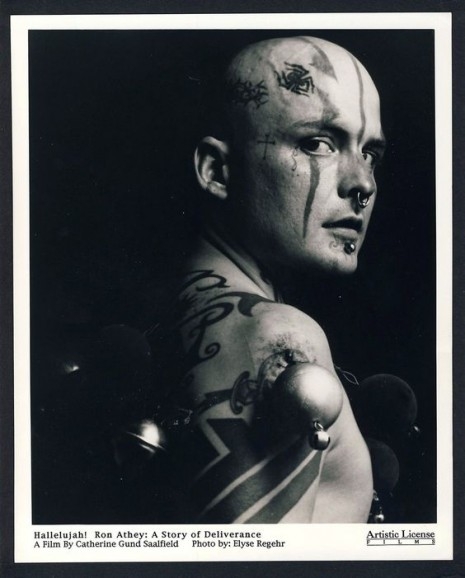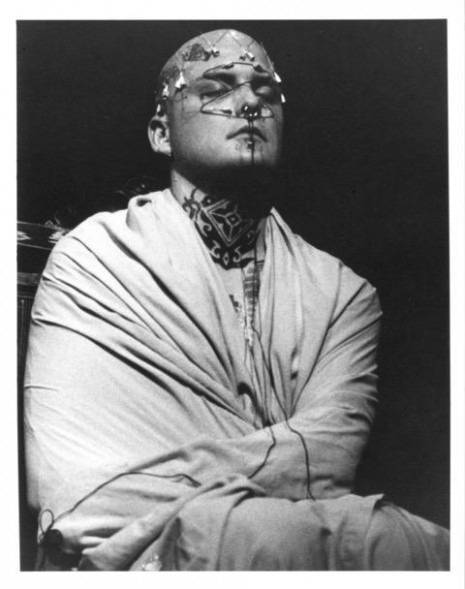
One of the great challenges of considering the work of a groundbreaking artist like Ron Athey is that we must consider how temporal and ephemeral his medium is. Peggy Phelan wrote, “Performance’s only life is in the present. Performance cannot be saved, recorded, documented, or otherwise participate in the circulation of representations of representations: once it does so, it becomes something other than performance.” Athey’s artwork runs the gamut from actions at Club Fuck! and Sin-A-Matic to collaborations with performers like Rozz Williams and Vaginal Davis and includes multiple-hour staged duration pieces with a team.
No documentation, audio recording or visual record could ever capture the drama or reverie achieved from actually attending a Ron Athey show but the existence of Catherine Gund’s documentary Hallelujah! Ron Athey: A Story of Deliverance (1997) is an excellent moving image tool to remind us how Athey altered the landscape of body modification, AIDS activism and performance art forever.
The Outfest Legacy Project is the largest publicly accessible collection of LGBTQ films in the world and was created specifically for the preservation and restoration of LGBTQ films. They will be screening Gund’s documentary in 35mm at UCLA this Friday in Los Angeles. Ron Athey and Catherine Gund will be there in person, as well as guest curator Zachary Drucker! Don’t miss out!
I thought this would be a great opportunity to ask Ron a few questions about his career and the film and other things he has been working on.
Please enjoy our conversation conducted via email this week.
**Heads’ up: the images contained are graphic. But they do represent some out of this world performance work, the likes of which we will probably never see again.**

I read an interview where you talked about growing up in a Pentecostal home in Pomona, CA and described the experience as an “apocalyptic opera.” While the links to ritualism, body focus/faith healing and automatic writing are clearly present in your various works, would it be fair to say that the romance of opera also plays a part in your constructions?
Ron Athey:I internalized all these images from the Book of Revelations and I think that even as a child I understood that they took on something else through the hillbilly gothic lens of Inland Empire revival meetings. I had no experience whatsoever with opera as an art form until I was fully adult and out of home. But in this school program for smart ass kids, the MGM program (mentally gifted minors), I was taken to the Pantages Theater to see Timbuktu, a spectacular starring Eartha Kitt. This had a huge effect on my sense of drama. But back to the setting of small Pentecostal meetings in storefronts, tents, private homes- the poverty and austerity of these settings was grim. Being raised in a neighborhood that was half Chicano (the other half black), I felt the iconography and glamour of Catholicism on a very deep level. What I lacked at that age was any way to reach the rituals.
The film Hallelujah! Ron Athey: A Story of Deliverance (Catherine Gund, 1997) playing this Friday as part of the Outfest Legacy Project covers four specific works and before you began exploring solo work with the glorious Solar Anus. Can you speak to Martyrs and Saints, Four Scenes in a Harsh Life, Deliverance and Gund’s film?
Ron Athey:The torture trilogy was almost channeled material. The height of the AIDS pandemic intersecting with the intense coming of age of the body modification scene was double high energy. These were two audiences that intersected but were also very different. I understand that I experience everything important through the archetype. As soon as the sickness and death came into my reality, it personalized as martyrology. Now I knew with that level of glorification, it was important to grab ahold of the issues, the moral polarization of “good girls” vs. “nasty girls”. The distortion of Healing: understand it, not as a restoration, but as an evolution through the sickness. This led me to concepts like the trickster shaman for Deliverance, wherein Divinity Fudge played multiple faces of a Living Icon. It was largely the same cast of performers through this era, and I work closely with Julie Tolentino. I think the staging of 8 to 25 performers wouldn’t have been possible without these skills! Martyrs & Saints was largely made of tributes of recent deaths (Cliff Diller, David Wojnarowicz) and owning that conviction to embrace the martyrology. Four Scenes was a refining of that St. Sebastian image, the Holy Woman who was largely based on Aimee Semple McPherson, and finally Deliverance, on the concept of healing and shabby shamanism.

This screening of Gund’s documentary for the Outfest Legacy Project is not the first time you have presented something with Outfest before. In the early 2000s, you worked with Vaginal Davis and curated an event called Platinum Oasis. Would you talk about this a little?
Ron Athey: In 2001 and 2002 Vaginal Davis and myself programmed Platinum Oasis, 24 hour events at the Coral Sands Motel in Hollywood, just before its debauchery and changing times ended its reign as a crystal meth/gay hardcore sex palace. It was designed as an intervention on both the concept of the group art show, and on abject gay male space. 40 rooms, plus a stage straddling the pool and jacuzzi area. This was a proper happening that triggered a lot of experimentation. Also the names are overwhelming and formed the repeating lineup of Bruce LaBruce, Kembra Pfahler, Slava Mogutin, Gio Black Peter, and had celebrity one offs, like Ogre of Skinny Puppy’s Japan porn room, Lydia Lunch’s tribute to the recently deceased theatre director Emilio Cubeiro, which included a slideshow of 1,000 self portraits of his own butthole taken throughout his life! Kenny Scharf drove up with his art-RV, and which happened to have members of the B-52s inside, Rick Owens designed a red toga which was custom sewn to attendees bodies in a “sweatshop” room. Ann Magnuson read from a Hollywood script that she should have gotten the part for, I could go on gushing but there was an incredible energy around this event. The hotel was donated, Outfest still had airline and hotel sponsorship, even with low artist fees we created something larger than the sum of its parts. And it was properly polymorphously perverse right up to the Sunday morning baptismal in the filthy bi-sexual jacuzzi, with Vaginal Davis in character as “I preach hate, my name’s St. Selecia Tate”.
Time and again, I seem to encounter variations of these words in reference to you and your work. What do they mean to you and how do you interpret them: Engage, Ecstatic, Extreme.
Ron Athey: How about enhance? I think, going back to the sacred, the passion play, the illustrated sermon, I don’t want to use my art time making commentary as everyday Ron Athey, about the specifics of the Trump presidency, and definitely not about the ‘art world.’ I have a deep impulse to find a higher state. Pure Immanence. Even the illusion of transcendence. Experimenting with what sounds, sights, smells, vibrations change consciousness. I always return to that.

Growing up in Hollywood, I used to drive by Poseur and Peanuts all the time. Club Fuck! and Sin-a-matic were constantly on my radar. I know you probably have a thousand stories but do you have one story you can tell about a performance you did that was particularly inspirational to you at the time?
Ron Athey: I was lucky I was able to work through actions on these stages, for these demanding crowds. Its very different then how I see work constructed in the academy, you have to rise up. One piece I made for Leigh Bowery’s memorial event, The Trojan Whore, I kept developing. I did a version at Sin-a-matic and sitting front center were Budgie and Siouxsie Sioux. I think it was about 1996. And it was a mummified enchanted body, corseted, bustled, boobed, and on a wheeled platform. Inside my genitals were “tucked” via surgical stapler, a two-meter strand of pearls keestered up my arse, and my lips were pieced inside out. When the pearls were removed (after I was placed in a wig and lipstick painted on the inside of my lips), the squeaky clean 2 meter double strand were looped a few times and placed around my neck. Afterwards, Siouxsie exclaimed, how on earth were the pearls so clean? Tricks of the trade.
Continues after the jump…





